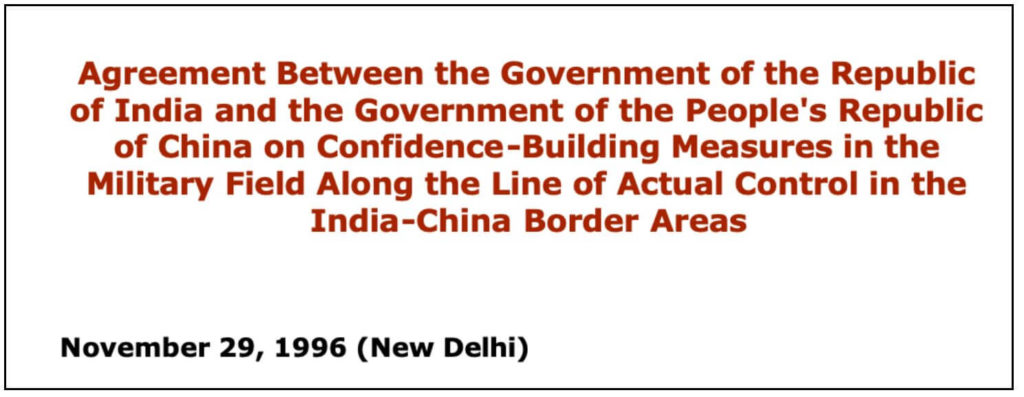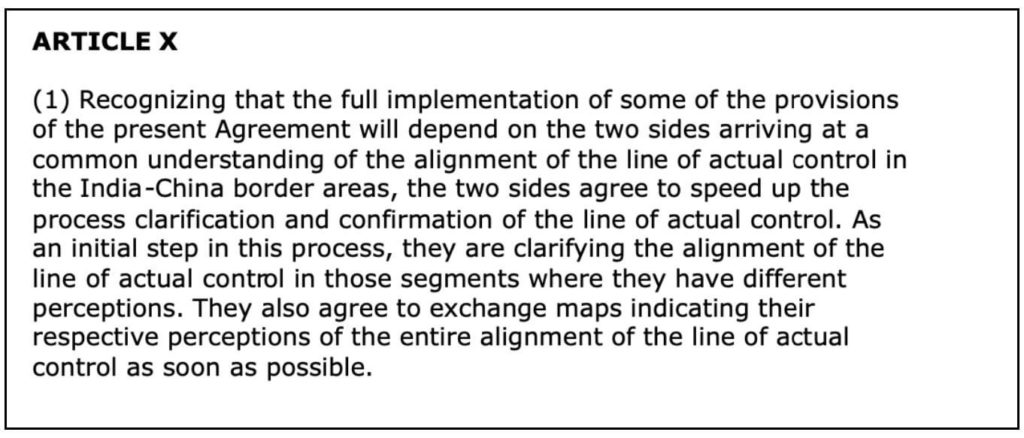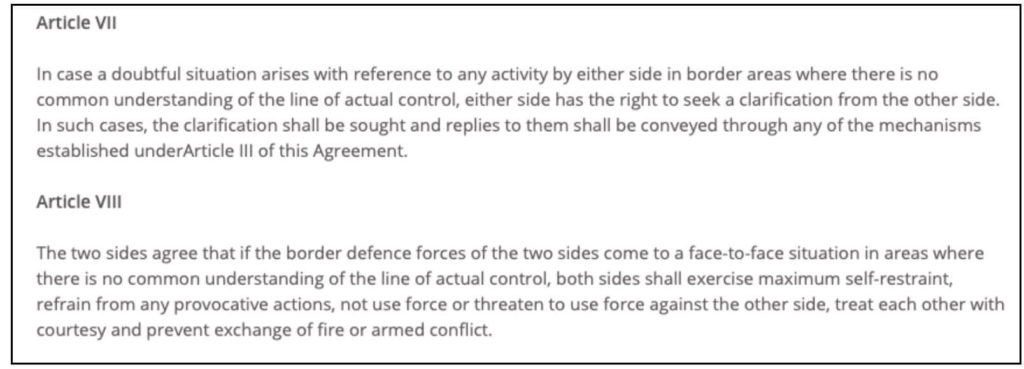For the first time in more than four decades, twenty Indian soldiers lost their lives in a face-off along the LAC on the Indo-China border. The number of Chinese casualties is not known. It was reported that it is a long-standing practice of not using firearms in border face-offs along the LAC. What are these agreements?
On 15 June 2020, Indian and Chinese troops engaged in a face-off in Galwan Valley across the Line of Actual Control (LAC). Indian Army sources stated that 20 Army personnel were killed in the clash, the worst such incident in the last few decades. This clash occurred amidst a de-escalation process being carried out after a stand-off over the past few weeks in various parts of Ladakh across the LAC.
As per various media reports, there were no firing between Indian and Chinese soldiers during the faceoff and the combat was a physical one where the Chinese were said to have used stones and metal clubs to attack. While there was no official statement from China, it is estimated that there were multiple causalities on their end as well.
Minister for External Affairs stated that Firearms not used as per India-China Agreements
The nature of the face off i.e. not using firearms, raised apprehensions if the Indian Army was not carrying any arms with them. Congress Leader, Rahul Gandhi via a tweet questioned government on sending the army personnel on the mission without arming them.

Responding to his tweet, the Minister for External Affairs, Dr. S. Jaishankar has tweeted that troops were carrying arms as is the norm while leaving their post. However, they did not use them in adherence to the agreements made in 1996 & 2005 agreements, which specify not to use firearms during face offs.

What are these Agreements?
In his tweet, Dr. Jaishankar made the reference of India-China agreements in 1996 and 2005. In 1996, India and China signed an agreement on ‘Confidence-Building Measures in the Military Field along the Line of Actual Control in the India-China Border Areas’. This agreement was in continuation of an earlier agreement, ‘Maintenance of Peace and Tranquillity along the Line of Actual Control in the India-China Border Areas’, which both the countries signed on 07 September 1993.

The first agreement made in 1993, was aimed at maintaining peace along the Line of Actual Control (LAC) along India-China Border and to work towards peaceful resolution of the border disputes existing between the countries. The 1996 agreement specifically laid out the protocols to be followed by the military of the both the countries across the border.

Article VI (1) of the agreement, prevents either from opening fire, conduct blasts or hunt with guns or explosives within two Kilometres of the border, on either side.
Article VI (4) of the protocol in the agreement is relevant to the situation that emerged in Galwan Valley. As per this article, the border personnel are supposed to exercise restraint by when a face-face situation arises due to difference in the alignment of LAC or other reasons.
Both the sides are required to enter into immediate consultations using diplomatic and other channels to review and prevent escalation of a situation.

However, unlike the protocol states, the forces were involved in a fight instead of exercising restraint. The protocols do not explicitly specify when to use firearms and what is to be done if either side does not exercise restraint and in face of provocation.
Common understanding from both the sides needed for implementation of some of the provisions
Article X(1) of the 1996 agreement provides a caveat regarding the implementation of some of the provisions on the agreement. As per the proviso in this article, the full implementation of some of the provisions in the agreement are dependent on both the countries arriving at a common understanding of the alignment of LAC across India-China borders.

With both the countries not coming to a common agreement on the alignment of borders, there is no clarity of the validity of few of the protocols.
In 2003, Atal Bihari Vajpayee, the then Prime Minister of India made a visit to China. As part of the bilateral interactions, there was ‘Declaration on Principles for Relations and Comprehensive Cooperation Between the Republic of India and the People’s Republic of China’

Regarding the question of India-China boundary, both the countries reiterated the need to maintain peace in border and to continue with the implementation of the agreements signed earlier, in wake of pending ultimate solution to the border issues.
Apart from 1996 agreement, Dr. Jaishankar also refers to 2005 agreement.
Article 1, of the agreement states that neither side should use or threaten to use force by any means, and it further calls for the resolution of the boundary dispute through peaceful resolution.

Article VII and VIII of Border Defence Cooperation Agreement-2013, reiterate the aspects highlighted in 1996 agreement regarding the response in cases of face-face situation regarding the non-agreement on border alignment i.e. to practice restraint and to explore diplomatic route for resolution.

In this context, the External Affairs Minister’s statement of not using firearms as a long-standing practice stands ground, as multiple agreements signed over the period of time reinforce this practice of exercising restraint.
More than 1000 Transgressions on LAC with no causalities between 2016-18
Responding to a question in Lok Sabha on 27 November 2019, the government stated that there were more than 1000 transgressions on the Indo-China border between 2016 & 2018 with no casualty. The government mentioned that transgressions do occur as both sides undertake patrolling up to their respective perception of the LAC. India & China both have differing perception of the LAC.

The government further stated that, both the countries have different perceptions about LAC in multiple areas. Hence patrolling alongside LAC as per their particular perceptions leads to transgressions.

Not using firearms was part of a long-standing tradition to prevent escalation
Few Defence experts opine, that although there is no specific coded rules, the practices have evolved over the years to not use fire arms or involve in any sort of activities that could escalate the situation. For example, one such action includes holding the barrel end down when patrols come face-face.
This has led to evolution of other arms like clubs, stone-pelting etc., which aren’t firearms but have been used by the Chinese army in such situations. Over the period of time, there have been instances of the usage of such weapons turning harmful as in the case of Pangong Lake Face-off where 72 soldiers were injured.
While engaging in face-face clashes along the LAC without using firearms, does seem to be a long-standing practice, the death of 20 soldiers marks an important milestone to review the nature of these engagements.
Featured Image: Line of Actual Control


